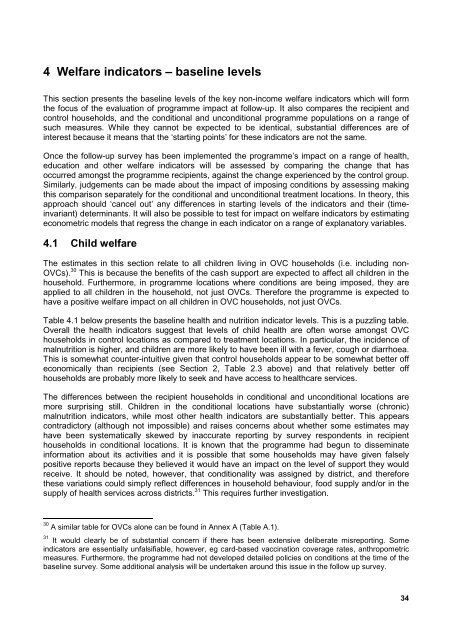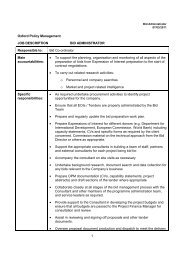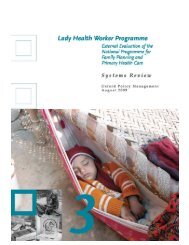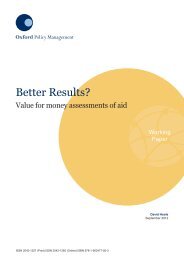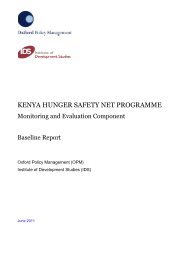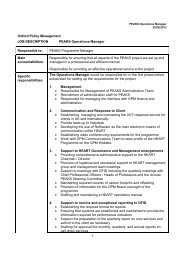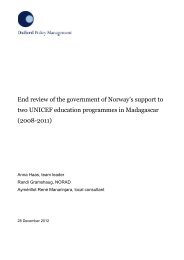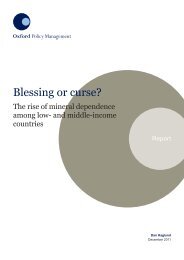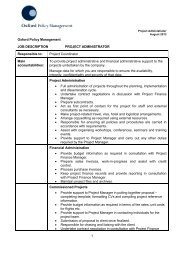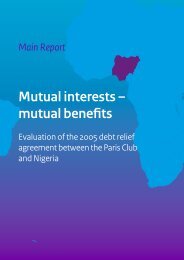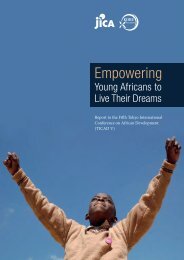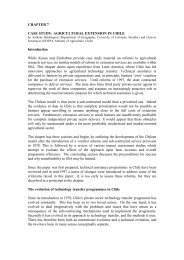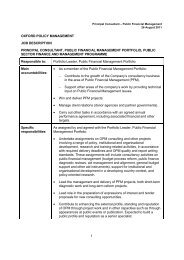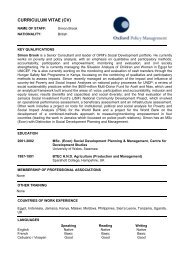Kenya OVC-CT Programme Operational and Impact Evaluation
Kenya OVC-CT Programme Operational and Impact Evaluation
Kenya OVC-CT Programme Operational and Impact Evaluation
Create successful ePaper yourself
Turn your PDF publications into a flip-book with our unique Google optimized e-Paper software.
4 Welfare indicators – baseline levelsThis section presents the baseline levels of the key non-income welfare indicators which will formthe focus of the evaluation of programme impact at follow-up. It also compares the recipient <strong>and</strong>control households, <strong>and</strong> the conditional <strong>and</strong> unconditional programme populations on a range ofsuch measures. While they cannot be expected to be identical, substantial differences are ofinterest because it means that the ‘starting points’ for these indicators are not the same.Once the follow-up survey has been implemented the programme’s impact on a range of health,education <strong>and</strong> other welfare indicators will be assessed by comparing the change that hasoccurred amongst the programme recipients, against the change experienced by the control group.Similarly, judgements can be made about the impact of imposing conditions by assessing makingthis comparison separately for the conditional <strong>and</strong> unconditional treatment locations. In theory, thisapproach should ‘cancel out’ any differences in starting levels of the indicators <strong>and</strong> their (timeinvariant)determinants. It will also be possible to test for impact on welfare indicators by estimatingeconometric models that regress the change in each indicator on a range of explanatory variables.4.1 Child welfareThe estimates in this section relate to all children living in <strong>OVC</strong> households (i.e. including non-<strong>OVC</strong>s). 30 This is because the benefits of the cash support are expected to affect all children in thehousehold. Furthermore, in programme locations where conditions are being imposed, they areapplied to all children in the household, not just <strong>OVC</strong>s. Therefore the programme is expected tohave a positive welfare impact on all children in <strong>OVC</strong> households, not just <strong>OVC</strong>s.Table 4.1 below presents the baseline health <strong>and</strong> nutrition indicator levels. This is a puzzling table.Overall the health indicators suggest that levels of child health are often worse amongst <strong>OVC</strong>households in control locations as compared to treatment locations. In particular, the incidence ofmalnutrition is higher, <strong>and</strong> children are more likely to have been ill with a fever, cough or diarrhoea.This is somewhat counter-intuitive given that control households appear to be somewhat better offeconomically than recipients (see Section 2, Table 2.3 above) <strong>and</strong> that relatively better offhouseholds are probably more likely to seek <strong>and</strong> have access to healthcare services.The differences between the recipient households in conditional <strong>and</strong> unconditional locations aremore surprising still. Children in the conditional locations have substantially worse (chronic)malnutrition indicators, while most other health indicators are substantially better. This appearscontradictory (although not impossible) <strong>and</strong> raises concerns about whether some estimates mayhave been systematically skewed by inaccurate reporting by survey respondents in recipienthouseholds in conditional locations. It is known that the programme had begun to disseminateinformation about its activities <strong>and</strong> it is possible that some households may have given falselypositive reports because they believed it would have an impact on the level of support they wouldreceive. It should be noted, however, that conditionality was assigned by district, <strong>and</strong> thereforethese variations could simply reflect differences in household behaviour, food supply <strong>and</strong>/or in thesupply of health services across districts. 31 This requires further investigation.30 A similar table for <strong>OVC</strong>s alone can be found in Annex A (Table A.1).31 It would clearly be of substantial concern if there has been extensive deliberate misreporting. Someindicators are essentially unfalsifiable, however, eg card-based vaccination coverage rates, anthropometricmeasures. Furthermore, the programme had not developed detailed policies on conditions at the time of thebaseline survey. Some additional analysis will be undertaken around this issue in the follow up survey.34


